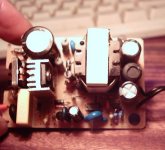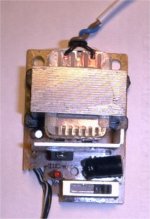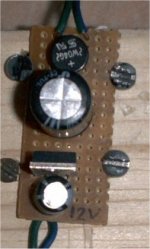A voltageregulator is only needed if you don´t know how much load you have
In correct!!
A voltage regulator regulates the voltage so u will only have the voltage you need kept at a certain level, (in the case of having too much), its just like a regulator on a gas bottle, same thing but with voltage.
Happy?
Trev
Power=
1 volts
2 amp's
A voltage regulator will only regulate the voltage, it is upto you to find a regulator that can handle your current draw! (amps)
1 volts
2 amp's
A voltage regulator will only regulate the voltage, it is upto you to find a regulator that can handle your current draw! (amps)
If we know the load which we do in this case (1 or 3 fans) we do not need any voltage regulator, if the voltage is to high add some diods in serie with the fans (one diod lower the voltage with 0.7V). Measure the voltage unloaded put some diods in serie so you get 12V, connect the fans, measure the voltage over the fans, remove one diod if it´s lower than 12V.
Why do it more complicated than it is ?
Why do it more complicated than it is ?
Just to add my 2 cents,
it pays to have a well regulated, clean dc voltage available to drive the fan(s) in a projector.
We're speaking of home theater here, right? AC residual components will add noise to the "turning" sound of the fan's dc motor, introduce EMI (radiation of electromagnetic energy) problems that could disturb nearby circuitry (such as TFT drivers) and add unneccessary heat to the fan's motor windings, as they are only driven by the "positive part" of the applied voltage. This also contributes to a quicker aging of the fan.
I'd suggest using something like Rod Elliot's project 5 (http://sound.westhost.com/project05.htm) with a 7812 (just the upper part of the schematic). The additional diodes and capacitors are good to protect the regulator in case of a short or a failing fan.
What level of regulation is needed depends on the fan and it's application. But I guess a comparison between good regulation and non-regulation can be made easily with a switch, once a regulator is built.
Hope this helps,
Sebastian.
it pays to have a well regulated, clean dc voltage available to drive the fan(s) in a projector.
We're speaking of home theater here, right? AC residual components will add noise to the "turning" sound of the fan's dc motor, introduce EMI (radiation of electromagnetic energy) problems that could disturb nearby circuitry (such as TFT drivers) and add unneccessary heat to the fan's motor windings, as they are only driven by the "positive part" of the applied voltage. This also contributes to a quicker aging of the fan.
I'd suggest using something like Rod Elliot's project 5 (http://sound.westhost.com/project05.htm) with a 7812 (just the upper part of the schematic). The additional diodes and capacitors are good to protect the regulator in case of a short or a failing fan.
What level of regulation is needed depends on the fan and it's application. But I guess a comparison between good regulation and non-regulation can be made easily with a switch, once a regulator is built.
Hope this helps,
Sebastian.
Sek
Heya Sek, nice find, thanks for the link, although the 1watt resistor in the pic near the 2 electrolitics looks abit burnt lol j/k
Trev🙂
Heya Sek, nice find, thanks for the link, although the 1watt resistor in the pic near the 2 electrolitics looks abit burnt lol j/k
Trev🙂
*lol* As you'll just need one half of the circuit, just take the "upper" half, it's resistor looks fine 😀
I see you have found "Rod Elliot's project" I really like his project, I have almost build all his projects.
I only want to mention that you can buy a ready made powersupply 12V 400mA stabilized for only €4, I used that in my diy-projector for 3 fans. Also the AC residual components depends on how big the cap is.
If people want to use a regulated or not regulated is just a money question. Add a lm7812 to Dwiel-s circuit and you got a regulated one.
I only want to mention that you can buy a ready made powersupply 12V 400mA stabilized for only €4, I used that in my diy-projector for 3 fans. Also the AC residual components depends on how big the cap is.
If people want to use a regulated or not regulated is just a money question. Add a lm7812 to Dwiel-s circuit and you got a regulated one.
Hi again,
Yep, of course (and they feature the above schematics), but glueing a wall-plug supply (or running a second mains cable) into a DIY projector just isn't cool 😀
Didn't want to steal Dwiel's work the show, I just couldn't find it on his site...
Thanks,
Sebastian.
you can buy a ready made powersupply 12V 400mA
Yep, of course (and they feature the above schematics), but glueing a wall-plug supply (or running a second mains cable) into a DIY projector just isn't cool 😀
Add a lm7812 to Dwiel-s circuit and you got a regulated one.
Didn't want to steal Dwiel's work the show, I just couldn't find it on his site...
Thanks,
Sebastian.
12v 2A Power Supply
This is a diy-forum so I just want to show how a Diy-powersupply look like. I use the one in the picture as a powersupply to my preamp-phono-riaa-stage, I think it took 2 minutes to build it. As the headline for this thread says this give 12V 2A (2000mA), cost for it €2 - 3 without a transformer. A cheap 12VAC 2A transformer, can you find in a 12V halogen lamp.
This is a diy-forum so I just want to show how a Diy-powersupply look like. I use the one in the picture as a powersupply to my preamp-phono-riaa-stage, I think it took 2 minutes to build it. As the headline for this thread says this give 12V 2A (2000mA), cost for it €2 - 3 without a transformer. A cheap 12VAC 2A transformer, can you find in a 12V halogen lamp.
Attachments
- Status
- Not open for further replies.
- Home
- General Interest
- Everything Else
- The Moving Image
- DIY Projectors
- Anyone want plans for 12v 2A Power Supply?


